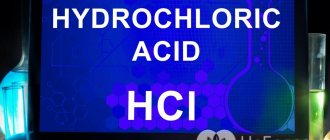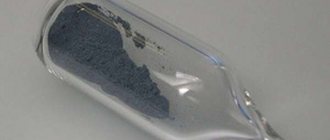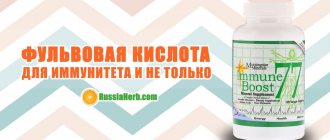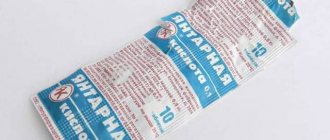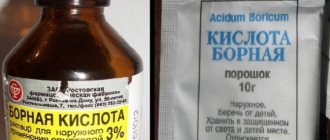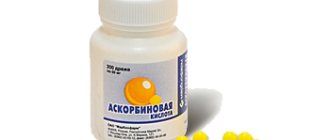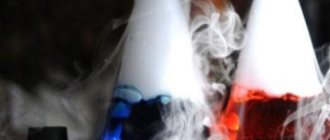Nitric acid
Impact on the human body
Aqueous solutions of hydrochloric acid pose a danger to humans if they come into contact with the skin and mucous membranes. In addition, concentrated acid solutions emit vapors that are hazardous if inhaled. The maximum permissible concentration for hydrochloric acid vapors in working areas of industrial enterprises is 5 mg/m3. The smell of vapor begins to be felt at a concentration of C = 2 mg/m3. Striking concentration C = 640 mg/m3.
When inhaling hydrochloric acid vapors, a person feels a sore throat and irritation of the mucous membranes of the mouth and nose. A dry cough, nausea and vomiting with mucus and blood appear. Acid vapors cause rapid swelling of the larynx and lungs, which leads to the death of the victim. Even weak concentrations of hydrochloric acid vapor cause destruction of tooth enamel.
Individual protection means
The respiratory organs and eyes are protected from hydrochloric acid vapors by filtering and insulating gas masks. For this purpose, filtering industrial gas masks of grade B, BKF and others that protect against acid gases, as well as civilian GP-5, GP-7 and children's gas masks can be used. To protect the skin, it is necessary to use skin protective equipment - rubberized suits, rubber boots and gloves.
Nitric acid (HNO3) is a colorless (unpurified acid is yellow) liquid with a pungent, suffocating odor. It dissolves well in water. Hydrochloric acid boils at a temperature Tbp = 82 °C, solidifies at a temperature Tzam = –41 °C. Acid vapor is 1.5 times heavier than air. The liquid is not flammable, but can ignite flammable substances. When mixed with alcohols, ethers, turpentine and mineral oils, it forms explosive mixtures. When released into the environment, it quickly forms water-soluble salts, so the compound can be considered unstable.
Nitric acid is widely used in the production of mineral fertilizers, explosives and rocket fuel oxidizers. Nitric acid is stored and transported in railway tanks.
Aqueous solutions of nitric acid cause burns if they come into contact with the skin and mucous membranes. In addition, the acid releases vapors and nitrogen oxides, which are hazardous if inhaled. The maximum permissible concentration for nitric acid vapors in working areas of industrial enterprises is 2 mg/m3. The smell of vapor begins to be felt at a concentration of C = 6 mg/m3. Striking concentration C = 260 mg/m 3.
When inhaling nitric acid vapor, a person feels a sharp pain in the throat, chest and stomach. A dry cough, nausea and vomiting with mucus and blood appear. The mucous membrane of the nose and lips quickly turns yellow. Acid vapors cause rapid swelling of the larynx and lungs, which leads to the death of the victim. Nitric acid fumes cause destruction of tooth enamel.
Individual protection means
The respiratory organs and eyes are protected from nitric acid vapors by filtering and insulating gas masks. For this purpose, filtering industrial gas masks of grade B, BKF and others that protect against acid gases can be used. Unfortunately, civilian gas masks GP-5, GP-7 and children's gas masks practically do not retain nitric acid vapors, especially nitrogen oxides - the protective effect time does not exceed several seconds. It is necessary to equip the gas mask with an additional cartridge DPG-3, which provides long-term (about 10 minutes) protection. To protect the skin, it is necessary to use skin protective equipment - rubberized suits, rubber boots and gloves.
Date added: 2014-11-06; ; Copyright infringement? ;
Your opinion is important to us! Was the published material useful? Yes | No
Mass fraction of calcined residue, %, no more
At the customer’s request, we provide nitric acid with a nitric acid concentration from 10% to 57% with the provision of certificates confirming the quality of these products.
Application of Nitric Acid:
Nitric acid is used in the form of aqueous solutions; it is one of the components of aqua regia and is found in assay acids. In industry, it is used to produce combined nitrogen fertilizers, for dissolving ores and concentrates, in the production of sulfuric acid, various organic nitroproducts, and in rocket technology as a fuel oxidizer. As a raw material in the production of ammonium nitrate, in metal pickling processes, for the separation of gold and silver. Nitric acid has also found application in the production of explosives, the production of intermediate products for the production of synthetic dyes and other chemicals in the food and non-food industries for washing process equipment (tanks, pipelines, conveyor lines, etc.), as well as eliminating residues of raw materials (dairy stones, etc.). In the electronic and radio-electronic industry, etc.
Classification
The damage caused by nitric acid, or more precisely poisoning with nitric acid, can, in general, be grouped as follows:
- Chemical burns, which cause a depressing effect on the eyes and skin;
- Inhalation effects harmful to the human respiratory system;
- A combination of lesions that can occur simultaneously with injuries caused by the explosiveness of the nitrogen mixture.
The main neurological symptoms of poisoning include unbearable headaches, loss of strength, coughing, convulsions, and possible coma. In case of severe intoxication, the main signs of the disease will be burns of the skin and mucous membranes of a person’s eyes, as well as the onset of pulmonary edema. So, depending on the severity of the chemical burn suffered, it is customary to distinguish:
- Erythema;
- Bubble;
- Neuroses of the dermis;
- Negative consequences that are already observed outside the skin.
As was said, when saturated with toxic vapors, symptoms such as pulmonary edema are observed, inflammation and catarrh can be caused, and changes occur in the pulmonary tree. If nitric acid poisoning is chronic, then the main symptoms include the onset of failures in the functioning of the heart muscle, catarrh of the respiratory system, and disturbances in the functioning of the main filter - the liver and digestive organs.
A fairly common case is simultaneous intoxication through breathing and through the skin. The symptoms in this case are joint in nature and first aid, accordingly, is complex.
We will talk about this in more detail later. Given the increased risk of explosion, it is important to understand that poisoning with nitric acid can occur simultaneously with serious injuries. It is logical that often the combined lesion will be more severe and have final consequences for human health.
The strongest organic acid
If we talk about the strongest acid in organic chemistry, then the leadership here belongs to formic acid. The substance was so named because it was found in the secretions of ants. Formic acid has a wide range of uses. It is often used in medicine because it has analgesic and irritant properties. Formic acid is present in many ointments that are used to treat bruises, varicose veins, and swelling. Medicines containing this substance can help get rid of acne.
Formic acid is also widely used in the chemical industry. It is also used in agriculture and beekeeping. The substance is also used in food as additive E236.
Despite its prevalence, formic acid can pose a serious threat. Contact of the concentrated substance with the skin causes burns or severe pain. Even inhaling formic acid vapor can cause damage to the respiratory tract. But the positive property of the substance is that it is quickly eliminated from the body without accumulating in it.
Speaking in the language of chemistry, acids are those substances that exhibit the ability to donate hydrogen cations, or substances that have the ability to accept an electron pair as a result of the formation of a covalent bond. However, in ordinary conversation, an acid is most often understood only as those compounds that, when formed in aqueous solutions, produce an excess of H30+. The presence of these cations in solution gives the substance a sour taste and the ability to react to indicators. In this material we will talk about which substance is the strongest acid, and also talk about other acidic substances.
Mechanism of action on the body
In this section, we propose to consider in more detail the consequences that nitric acid poisoning has on:
- organs of vision;
- skin;
- respiratory system.
So, when acid interacts with the dermis, it causes dehydration. If it gets into the eyes, the most dangerous thing is damage to the eye cornea. Human pulmonary edema occurs with fluid retention throughout the body. All this is due to the fact that the pressure level in the capillaries increases, and there is a disruption in the normal outflow of lymph. The onset of toxic edema is explained by the cauterizing effect of toxic vapors on the human lungs. As a result of the toxic effect on the entire body, disruptions in the functioning of the heart and all blood vessels occur, and the first symptoms of “new problems” with health appear. There are many reasons for this:
- blood viscosity increases, which increases pressure on the heart muscle;
- blood vessels dilate under the influence of poisons;
- pulmonary edema and oxygen deficiency occur, which together complicate the work of the heart;
- irregularities in heart rhythm and sudden jumps in blood pressure;
- negative effects on the cardiovascular system.
Nitrogen: features and applications
Nitrogen is an invisible gas that has no color, taste or smell. Gas is widely used in industry, in particular in the transportation of petroleum products and liquid fuels. Nitrogen is released into the atmosphere as a byproduct of rocket fuel refining. Divers encounter the negative effects of nitrogen on the human body during deep dives, as well as when working deep underground. In everyday life, nitrogen poisoning can be obtained by using fertilizers that contain nitrogen or are created on the basis of this substance.
Nitric acid HNO3
Nitrogen oxides are also used in medicine in the treatment of heart disease and pulmonary failure. In addition, 80% of nitrogen is contained in the air, as well as in a number of amino acids in the human body; here the mass fraction of nitrogen sometimes reaches 2.5%.
Nitric oxide is also contained in food additives, for example, E-942.
Urgent measures
First aid for poisoning with nitric acid, because in a situation where nitric acid gets on the surface of the skin, it is to rinse the damaged area under intense water pressure for 15 minutes. After this, you need to use a soda solution to further wash the skin. In case of intoxication with vapors, the eyes should be washed with a solution of soda and dripped with novocaine. If saturation occurs through the respiratory tract, then first aid will be to ensure air access to the person. In order to make breathing easier, it is recommended to remove the person’s clothing. First aid aimed at normalizing the functioning of the heart muscle and respiratory system is to use the following mixture for inhalation: chloroform in a volume of forty drops, ethyl alcohol - forty drops, ammonia - five drops and ether - twenty drops. Subsequent use of inhalations, the main component of which is soda, will also have a positive effect. Spasms in the bronchi lead to suffocation, in which case atropine will be a rescue remedy. If there is a threat of a complete stop of respiratory activity, you should be careful with artificial respiration, since in the presence of pulmonary edema, such first aid can cause even greater harm.
If all first aid is performed in the initial seconds of a burn, then serious consequences can really be avoided.
Treatment
After poisoning, the patient should be in the hospital in a state of complete rest. The doctor makes a diagnosis, determines the toxic substance and the degree of its effect on the body, and prescribes therapy.
In case of nitrous oxide (N2O) poisoning, the respiratory system is brought back to normal with the help of carbogen (a mixture of oxygen and carbon dioxide). Thanks to it, blood flow is restored and the possibility of tumor development is suppressed. A glucose solution is injected intravenously to ensure stable functioning of the heart muscle.
For nitrogen dioxide (NO2) poisoning, the same treatment is given. Instead of glucose, calcium chloride is introduced into the bloodstream. Complex oxygen therapy is prescribed.
Nitric oxide (NO) poisoning results in its replacement of oxygen in hemoglobin. If it is inhaled for a long time, suffocation occurs. If there is access to fresh air, then the connection is unstable, and the process is reversible. In addition, it is destroyed in air, turning into nitrogen dioxide, so dioxide intoxication is treated.
Preventive actions
To avoid the terrible consequences of poisoning, it is important to adhere to simple rules, which include using special clothing and gas masks when in contact with such acid, observing personal hygiene rules, ensuring good ventilation in the workplace, monitoring and preventing poison spills, and in an emergency, create all conditions for its prompt collection. It is important to familiarize and provide instructions on how first aid should be provided in an emergency. As preventive measures to prevent the chronic nature of the disease, in order to avoid poisoning with nitric acid, it is recommended that enterprises conduct medical monitoring of the health status of employees and include dishes rich in vitamins in the menu.
Carborane acid is the strongest in the world
In 2005, scientists working at the University of California in the USA managed to create a new acid of unprecedented strength. The invented compound is a million times stronger than concentrated sulfuric acid. Scientists at that moment set out to find a new molecule that would become a real discovery in the scientific world, and they managed to achieve a positive result.
The formula of carborane acid is not very complex: H(CHB11Cl11). But it will still not be possible to synthesize such a substance in an ordinary laboratory. Carborane acid is more than a trillion times more acidic than ordinary water.
The most flammable substance
Lots of things burn at an astonishing rate, such as styrofoam, napalm, and that's just the beginning. But what if there was a substance that could set the earth on fire? On the one hand, this is a provocative question, but it was asked as a starting point. Chlorine trifluoride has the dubious reputation of being a horribly flammable substance, even though the Nazis believed the substance was too dangerous to work with. When people who discuss genocide believe that their purpose in life is not to use something because it is too lethal, it supports careful handling of these substances. They say that one day a ton of the substance spilled and a fire started, and 30.5 cm of concrete and a meter of sand and gravel burned out until everything calmed down. Unfortunately, the Nazis were right.
Sulfuric acid (H2S04)
Few acids are better known than sulfuric acid. Indeed, in terms of production volumes, H2S04 is the most common. That is why it is the most dangerous acid in the world.
The substance is a strong acid with two bases. The sulfur in the compound has the highest oxidation state (plus six). It is odorless and colorless. Most often used in solution with water or sulfuric anhydride.
There are several ways to obtain H2S04:
- Industrial method (dioxide oxidation).
- Tower method (production using nitric oxide).
- Others (based on obtaining a substance from the interaction of sulfur dioxide with various substances, are not very common).
Concentrated H2SO4 is very strong, but its solutions also pose a serious danger. When heated, it is a fairly strong oxidizing agent. When interacting with metals, they oxidize. In this case, H2S04 is reduced to sulfur dioxide. H2SO4 is very caustic. It can affect the skin, respiratory tract, mucous membranes and internal organs of humans. It is very dangerous not only to get it inside the body, but also to inhale its vapors.
Properties [edit | edit code ]
Colorless, highly hygroscopic crystalline substance. Can be distilled under high vacuum. Hydronium salt forms with water and air moisture. Does not work on glass. As a strong acid it can act on the skin, but its sodium salt has low toxicity. How a strong acid can react with metals to form hydrogen, forming salts and releasing hydrogen.
Carborane acid is approximately a million times stronger than concentrated sulfuric acid. It is not possible to measure the strength of an acid using conventional scales, since the acid protonates all known weak bases and all solvents in which it dissolves.
Protonates benzene to give a stable benzene salt. Protonates fullerene-60, sulfur dioxide.
Currently, the strongest known acid that can be stored in the laboratory is fluorinated carborane acid.
The most magnetic substance
If the inductor were a small black piece, then it would be the same substance. The substance, developed in 2010 from iron and nitrogen, has magnetic powers that are 18% greater than the previous record holder and is so powerful that it has forced scientists to reconsider how magnetism works. The person who discovered this substance distanced himself from his studies so that no other scientist could reproduce his work, since it was reported that a similar compound was developed in Japan in the past in 1996, but other physicists could not reproduce it, so this substance was not officially accepted. It is unclear whether Japanese physicists should promise to make Sepuku under these circumstances. If this substance can be reproduced, it could herald a new age of efficient electronics and magnetic motors, perhaps enhanced in power by an order of magnitude.
News
from 01/01/2017
This user (licensing) agreement (hereinafter referred to as the “Agreement”) is concluded between the Limited Liability Company “ALECTA” (hereinafter referred to as the “Licensor”) and the User (an individual acting as the final consumer of the Product), collectively referred to as the “Parties”.
Please read the text of this Agreement carefully. It constitutes a public offer and, after its acceptance by you, forms an agreement between you (the User) and the Licensor on the subject matter and on the terms set forth in the text of the Agreement.
By accepting this Agreement, you agree to the terms, policies, and applicable terms of the license agreement set forth below.
1. TERMS AND DEFINITIONS 1.1. Software product - copies of the KhiShnik computer program, consisting of the Server part (certificate of state registration of the database No. 2014621526) and the Client application (certificate of state registration of the computer program No. 2014661592), the rights to use which are granted in accordance with this Agreement . 1.2. Server part is a part of the Software Product located on the Internet and used for storing data in the Licensor’s database under the name “HiShnik” (hereinafter also referred to as the “database”), as well as for storing, processing, transferring User data between the database and the client application. 1.3. Client application is a part of the Software Product that is installed on the User’s computer or mobile device and allows access to the Licensor’s database, as well as User data stored in the memory of the Licensor’s server. 1.4. User (licensing) agreement – the text of this Agreement with all additions, changes, appendices to it, posted on the Licensor’s website and available on the Internet at: https://www.hishnik-school.ru 1.5. Conclusion of a User (licensing) agreement (acceptance of a public offer) - full and unconditional acceptance of the terms of this Agreement by the User by performing one (or more) of the following actions by the User: registration and (or) authorization on the Licensor’s Website in the manner established by it; making a payment for granting the right to use the Software Product; the beginning of the User's use of the Software Product in any other form. 1.6. Licensor is a party to this Agreement that has the exclusive right to the Software Product and grants, under this Agreement, the User the right to use the Software Product, within the limits and in the manner specified in this Agreement. 1.7. User - an individual who installs the Client Application on a computer or mobile device and uses it. 1.8. Non-exclusive license - a license agreement providing for the right to use the Software Product while preserving the Licensor’s right to conclude a license agreement with other persons. 1.9. Role is a set of functions that are available to the User in the Software Product. This Agreement provides for the following roles: 1.9.1. Administrator is an employee of an educational institution who registers and provides access to the Software Product to Users who participate in the educational process in the educational institution. 1.9.2. A teacher is an employee of an educational institution who organizes and carries out the educational process through the use of the functions of the Software Product. 1.9.3. A tutor - a teacher who gives private lessons, can conduct both individual and group lessons by using the functions of the System outside the framework of the Educational Institution. 1.9.4. Student – a student studying in an Educational Institution and (or) outside it, receiving and testing his knowledge through the System. 1.10. Profile is a record in a database containing identifying information about the User and his role. 1.11. Demo mode is a mode of using the Software Product for the purpose of familiarizing yourself with its functionality. 1.12. Productive mode – mode of use of the Software Product for the purposes of application in the educational process. 1.13. Registration key is a set of numbers and letters through which the User receives the right to use the Software Product in Productive mode with full access to the Server part. 1.14. Login is a unique identifier of the User in the database. 1.15. Password is a set of numbers and letters through which, together with the Login, the User gains access to the Client Application of the Software Product. 1.16. The Licensor’s website is https://www.hishnik-school.ru. 1.17. Content - all objects posted on the Site and in the Software Product, including design elements, text, graphics, illustrations, videos, scripts, programs, music, sounds and other objects and their selections. 2. SUBJECT OF THE AGREEMENT 2.1. The Licensor grants the User the right to use the KhiShnik Software Product under the terms of a simple (non-exclusive) license within the limits and in the manner specified in this Agreement, and the User undertakes to pay the Licensor a fee for granting the right to use the Software Product in accordance with the terms of this Agreement. 2.2. The Licensor guarantees that he is the copyright holder of the exclusive rights to the Software Product and has the rights to enter into an Agreement. The Licensor is currently not aware, to the best of his knowledge, of the rights of third parties violated by this Agreement. 2.3. The User does not have the right to fully or partially grant (transfer) the rights received by him under the Agreement to third parties, including selling, replicating, copying the Software Product, providing access to third parties, alienating in any other way, incl. free of charge, without obtaining the prior written consent of the Licensor for all of the above actions. 2.4. The Agreement provides the User with the right to use the Software Product while retaining the Licensor’s right to issue licenses to other persons. The User may use a copy of the Software Product only within the limits of those rights and in the ways provided for in the Agreement. The right to use the Software Product granted to the User by the Licensor is valid for the duration of the Agreement. 2.5. The KhiShnik software product, consisting of a Server part and a Client application, is a computer program designed to carry out the educational process. 2.6. The right to use the Software Product (non-exclusive license) granted to the User in accordance with this Agreement includes the right to use the Software Product in two modes: 2.6.1. Demo mode, limited to the right to install on a computer or mobile device, launch, configure the Client application and limited access to the Server part, for the purpose of familiarizing yourself with the functionality of the Software Product. 2.6.2. Productive mode, limited by the right to install on a computer or mobile device, launch, configure the Client application and full access to the Server part, for the purpose of using the Software Product in the educational process. 2.7. The right to use the Software Product is granted: 2.7.1. In demo mode - from the moment the Client application is installed on a computer or mobile device. 2.7.2. In productive mode - from the moment funds are received into the Licensor’s account. 2.8. The rights to use the Software Product are considered granted to the User: 2.8.1. In demo mode - at the time of installing the Client application on a computer or mobile device. 2.8.2. In productive mode - at the time a letter with a registration key is sent to the User by email. 2.9. The right to use the Software Product is granted both on the territory of the Russian Federation and on the territory of all other countries of the world, unless it contradicts the national legislation of these countries. 2.10. The requirements for computers (equipment) necessary for the operation of the Client Application are posted on the Internet on the Licensor’s website. 3. COST AND PAYMENT PROCEDURE 3.1. The amount of the Licensor's remuneration for providing the User with the rights to productive use of the Software Product is posted on the Licensor's Website. 3.2. The Licensor's remuneration for granting the rights to productive use of the Software Product is not subject to VAT on the basis of subclause 26 of clause 2 of Article 149 of the Tax Code of the Russian Federation. 3.3. Payment for the granted rights for the productive use of the Software Product under this Agreement is made by the User in the form of annual payments. 3.4. Payment method under the Agreement: non-cash transfer by the User of funds in the currency of the Russian Federation (ruble) to the Licensor’s bank account using the methods indicated on the Licensor’s Website. In this case, the User’s obligation to pay remuneration under the Agreement is considered fulfilled from the day the bank credits the funds to the Licensor’s account. 3.5. The Licensor has the right to unilaterally change the terms and amount of remuneration under this Agreement. The current remuneration amount is published on the Licensor’s Website. 4. TERM OF THE AGREEMENT 4.1. This Agreement comes into force from the moment of its conclusion in accordance with clause 2.7. 4.2. The period for granting the right to productive use of the Software Product in accordance with the Agreement is 1 (One) year from the date of authorization of the User through the Registration Key. The agreement is considered concluded on the same terms for a new term equal to 1 (One) year, subject to the User making full payment for the extension of the right to productive use of the Software Product. The number of extensions is not limited. 4.3. Granting the right to demo use the Software Product is not limited in duration. 4.4. Termination of this Agreement is possible in accordance with the conditions specified in the current legislation of the Russian Federation. 5. RIGHTS AND OBLIGATIONS OF THE PARTIES 5.1. The user undertakes: 5.1.1. Respect the Licensor's rights to the Software Product and not use the Software Product in other ways other than those provided for in this Agreement. 5.1.2. Do not attempt to obtain the source code of the Software Product for its further use, and do not extract database materials. 5.1.3. Timely pay the Licensor remuneration for granting the User the right to productive use of the Software Product in the manner and within the time limits established by this Agreement. 5.1.4. Provide accurate information, including your email address and other data requested by the Licensor. Moreover, if the User provides false information, the User assumes all possible risks that may arise in connection with the implementation of this Agreement. 5.1.5. Strictly adhere to and not violate the terms of the Agreement, as well as ensure the confidentiality of the Licensor’s commercial and technical information. 5.1.6. Do not install the Software Product on computers (equipment) that do not meet the technical requirements for the operation of the Software Product. 5.1.7. Make sure that the Licensor's rights to the Software Product are not violated by third parties in the territory of this Agreement, and is obliged to inform the Licensor about all violations that become known to him. 5.2. The user has the right: 5.2.1. Use the Software Product only by installing (recording) the Client Application of the Software Product on a computer or mobile device and setting it up to carry out the introductory or educational process using the database. 5.2.2. Use the Software Product for any purpose of the User, except for the restrictions specified in the Agreement. 5.3. The Licensor undertakes: 5.3.1. Provide technical conditions for the functioning of the Server part and the Client application for the use of the Software Product by the User, including ensuring the possibility of obtaining and/or providing a distribution kit (installation files) of the Client application with the help of which the Software Product is used. 5.3.2. Protect the User’s data that became known to the Licensor in connection with the Parties’ fulfillment of their obligations in accordance with this Agreement. 5.3.3. Notify the User of the impossibility of using the Software Product due to maintenance work at least 48 (Forty-eight) hours in advance by sending a message to the email specified during registration. 5.3.4. Refrain from any actions that could make it difficult for the User to exercise the right granted to him to use the Software Product within the limits established by the Agreement. 5.3.5. Provide new versions (updates) of the Software Product by posting them on the Internet on the Licensor’s website or in the Google Play system with the ability to download. 5.3.6. Inform the User about new versions (updates) of the Software Product by sending a notification to the User's email address specified during registration and (or) authorization on the Licensor's Website. 5.3.7. Provide round-the-clock reception of requests to the Support Service at the email address: [email protected] 5.3.8. Process received requests and consultations through the Support Service, from 5:00 to 14:00 Moscow time, Monday to Friday, excluding weekends and holidays. 5.4. The licensor has the right: 5.4.1. Carry out service work that may result in interruptions in the operation of the Client Application. 5.4.2. If the User violates the terms (methods) of using the rights to the Software Product in accordance with this Agreement, deprive the User of the license to use the rights to the Software Product by closing access to the Software Product. 5.4.3. Unilaterally change the terms of this Agreement in accordance with the established procedure. 5.4.4. Refuse unilaterally to execute the Agreement in the manner prescribed by applicable law and/or this Agreement; 5.4.5. Exercise other rights provided for by applicable law, as well as this Agreement. 6. PROCEDURE FOR USING THE SOFTWARE PRODUCT 6.1. To use the Software Product, the User is asked to install (save into the computer memory) and launch the Licensor's Client Application, a copy of which is downloaded by the User independently in one of the following ways: on the Internet on the Licensor's website; in the Google Play system; from a flash drive provided by the Licensor (optional). 6.2. After installation (recording to the computer memory) and launch of the Licensor's Client Application, the User is granted the right to use the Software Product in Demonstration mode. 6.3. To use the Software Product in Productive mode, the User must enter the Registration Key in the Client Application, which the Licensor sends to the User to the email address specified on the Licensor’s Website in the request for access. The User independently uses the Software Product by launching and configuring the Client Application. 6.4. The Software Product is provided to the User on an “as is” basis, which means: the User is aware of the most important functional properties of the product for which the rights to use are granted, the User bears the risk of compliance of the Software Product with his wishes and needs, as well as the risk of compliance conditions and scope of rights granted to their desires and needs. The Licensor is not liable for any loss or damage, regardless of the reasons for their occurrence (including special, incidental or consequential damages; damages associated with lost profits, business or production interruption, loss of business information, negligence, or any other losses) arising from the use or inability to use the Software Product. 6.5. The software product is intended for personal, educational and other non-business needs of individuals. Use of the Software Product for commercial purposes is not permitted. 7. RESPONSIBILITY OF THE PARTIES 7.1. For failure to fulfill or improper fulfillment of obligations under this Agreement, the Parties are liable in accordance with current legislation, unless otherwise provided by the Agreement. 7.2. The Parties are released from liability for non-fulfillment (improper performance) of the Agreement if such non-fulfillment (improper performance) was the result of force majeure circumstances, the occurrence of which the Parties could not foresee and prevent. A Party for which proper fulfillment of an obligation has become impossible due to force majeure circumstances is obliged to immediately notify the other Party about this. The parties have the right to refer to force majeure circumstances only if they have done everything possible to prevent and/or minimize the negative consequences of these circumstances. 7.3. The Licensor does not guarantee absolute uninterrupted use of the Software Product and does not guarantee that computer programs produced by third parties or any other means used in the operation of the Software Product are absolutely protected from computer viruses and other harmful components. The licensor agrees to carry out all reasonable measures to protect the user's information and ensure uninterrupted use of the software product. 7.4. The user independently is responsible for the content of the information transmitted by him or other person on the Internet and stored in the memory of the Licensor server, including its reliability and the legality of its storage and distribution. 7.5. In case of licenser to be held accountable or imposed on him in connection with the user's violations of third parties, as well as the prohibitions or restrictions established by the law, the user must fully compensate the losses of the licensor. 7.6. In case of a violation by the User, the conditions and restrictions of this Agreement, he is a violator of the exclusive right to a software product. For a violation of copyright for a software product, the user is responsible in accordance with the legislation of the Russian Federation. 7.7. The total cumulative liability of the Licensor to the User in relation to the requirements of any kind arising from this Agreement will not exceed the amount of remuneration under this agreement, actually paid by the User for the software product in respect of which the requirement arose within 12 (twelve) months preceding the occurrence of the requirement . The above restrictions on liability are applied even if, with the help of the above method of protecting the right, it is not possible to achieve its main goal. 8. Personal data 8.1. The information provided by the user is confidential. 8.2. Providing his personal data to the licensor, the user agrees to process it, both using automation tools and without the use of automation tools, in particular collecting, storing, transferring to third parties and using information by a licensor in order to fulfill obligations to the user in accordance with this Agreement; User receiving personalized advertising; Checks, research and data analysis to support and improve the software product. 8.3. The licensor undertakes not to disclose the information received from the user. It is not considered a violation of the provision by the licensor of information, including personal data of the user to third parties acting on the basis of an agreement with a licensor in order to execute this Agreement. 8.4. It is not considered a violation of obligations to non -disclosure of information provided by the User, including the personal data of the User, in order to ensure compliance with the requirements of the current legislation of the Russian Federation (including in order to prevent and/or suppress illegal and/or illegal actions of users). 8.5. The user does not have the right to transfer his username and password to third parties. 8.6. The user undertakes to ensure the confidentiality of his login and password and is responsible for using the login and password by third parties. Under no circumstances, the Licensor is not responsible for the use of the Login and Password of the User. 8.7. In the event of an unauthorized access to the login and password and/or the user's personal page, or the distribution of the login and password, the user must immediately inform the licensor by filling out the feedback form presented on the site. 8.8. The licensor is not responsible for the use of anyone in public personal data of users. 9. Exceptional rights to content 9.1. All objects posted on the site and in the software product, including design elements, text, graphic images, illustrations, videos, scripts, programs, music, sounds and other objects and their collections (hereinafter - content), are objects of exclusive licensor rights , all rights to these objects are protected. 9.2. Except cases established by this Agreement, as well as the current legislation of the Russian Federation, content cannot be copied (reproduced), processed, distributed, displayed in the frame, published, downloaded, transferred, sold, or otherwise used in unit without prior resolution of the copyright holder , except when the copyright holder clearly expressed his consent to the free use of content by any person. 9.3. User use of content, access to which is obtained exclusively for personal non -profit use, is allowed subject to all the signs of authorship or other notifications of authorship, preserving the author’s name in a constant form, preserving the work in a constant form. 9.4. Any use of content, except for the copyright holder permitted in this Agreement or in the case of the clearly expressed consent of the copyright holder, is strictly prohibited without the preliminary written permission of the copyright holder. 10. Other conditions 10.1. All disputes and disagreements arising in connection with the execution and (or) interpretation of this Agreement are resolved by the parties through negotiations. If it is impossible to resolve the sides of the disagreements through negotiations, the dispute must be permitted in the arbitration court at the location of the defendant with the obligatory compliance of the claims of disputes and disagreements. The deadline for the response to claim 30 (thirty) calendar days from the date of its receipt in writing or in electronic form. 10.2. None of the provisions of this Agreement is and cannot be considered as the transfer (alienation) of exclusive rights to the intellectual property of the licensor. 10.3. In case of receipt of comments from the user to the software product provided under this Agreement, such comments are subject to consideration by a license at his request and are optional for accounting. 10.4. The terms of this agreement apply to subsequent versions of the software product, which are its updates. Conclusions of other agreements regarding the updates of the software product are not required. 10.5. In everything else that is not provided for by this Agreement, the parties are guided by the current legislation of the Russian Federation. 11. Address, details of the licensor of Alekta LLC Legal address: 630090, Novosibirsk, Academician Academician Lavrentieva 2/2. Postal address: 630090, Novosibirsk, Academician Lavrentiev Academician 2/2. OGRN 1025403657135 TIN 5408128408 KPP 540801001 OKVED 72.19, 62.01, 62.02, 68.20.2; OKPO 26335100; OKATO 50401384000; OKFS 16; OKOPF 65. E-mail
